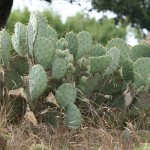Pricklypear
Opuntia Mill. spp.
Cactaceae (Cactus family)
Description
Pricklypear consists of jointed and flattened stems called pads or cladophylls. The plant's ability to store water in its flattened, fleshy stems enables it to withstand long dry or drought periods. Although these highly modified stems are not leaves, they can conduct photosynthesis. True Pricklypear leaves are tiny; they appear only briefly at each cluster of spines when new pads emerge. It is often difficult to differentiate among species of Pricklypear, mainly because of the way the plant reproduces. Each pad, if broken away, can form a new plant that is genetically identical to the original plant. Given enough time, an especially strong, adapted Pricklypear can spread over a large area as its pads become scattered. Shredding Pricklypear helps spread the plant and increase its density in a pasture. Pricklypear fruits, or tunas, are eaten by people as well as cattle, sheep, goats, deer, javelina, turkeys, and a wide assortment of other animals that process the pulp and pass the seeds through their digestive systems. Some landowners may burn Pricklypear to remove the spines, so the pads can be consumed by livestock when forage is scarce.Habitat
Pricklypear grows throughout the Texas ecoregions in a variety of habitats, from dry gravel or rocky, shallow soils to heavy, deep, clay soils. It is a common invader of grasslands and shrublands.Images
Plant Characteristics
Flower Color: Pink, Yellow
Seed Type: Fruit/Berry
Duration: Perennial
Stem Texture: Prickly, Spiny, or Thorny
Growth Habit: Shrub (Woody)
Season: Evergreen
Distribution
 : 01 - Pineywoods, 02 - Gulf Prairies and Marshes, 03 - Post Oak Savannah, 04 - Blackland Prairies, 05 - Cross Timbers and Prairies, 06 - South Texas Plains, 07 - Edwards Plateau, 08 - Rolling Plains, 09 - High Plains, 10 - Trans-Pecos
: 01 - Pineywoods, 02 - Gulf Prairies and Marshes, 03 - Post Oak Savannah, 04 - Blackland Prairies, 05 - Cross Timbers and Prairies, 06 - South Texas Plains, 07 - Edwards Plateau, 08 - Rolling Plains, 09 - High Plains, 10 - Trans-Pecos
Distributions
Distribution refers to the ecological region in Texas that a plant has been found. You can also view a clickable map.
Book: Brush and Weeds of Texas Rangelands (B-6208)
Collection: Brush and Weeds






